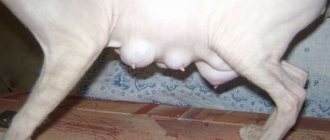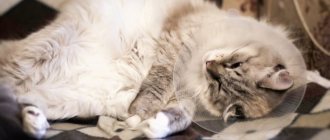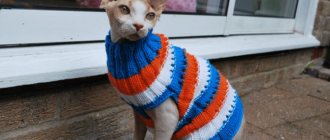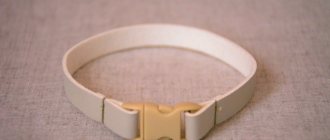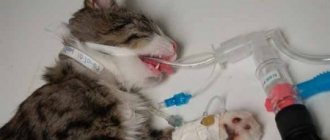11625Administration
1
Castration (sterilization) of a domestic cat is a simple operation. It lasts 10-20 minutes, but requires certain postoperative care for the animal. Very little time passes after surgical manipulations, and the moment comes when it is necessary to remove the suture material. If possible, it is best to entrust this procedure to a professional veterinarian.
But there are reasons why some furry pet owners cannot go to the doctor. In this case, you can remove the threads yourself, having first studied the detailed instructions for carrying out such manipulations. This article will tell you when to remove stitches after sterilizing a cat, and whether this procedure can be carried out at home.
How many days after surgery should stitches be removed?
It all depends on the specific case. The condition of the postoperative wound plays a huge role.
By the time the suture material is removed, it must meet the following requirements:
- The cut line may be rough, the stitches of the sutures are clearly visible, but the presence of bloody discharge, blood crusts or exudate is unacceptable.
- You need to feel the seam. If everything is in order and the suture material can be removed, then the local temperature will be normal.
- Swelling and redness of the postoperative wound are also unacceptable.
As a rule, the suture reaches this state by the tenth day after surgery, in some cases you have to wait two or three weeks (this does not happen often).
How many days after endoscopic surgery can the suture be removed? The suture is rarely longer than five millimeters; there is no need to rush to remove it. Haste can leave the animal's abdominal cavity open to bacterial contamination.
Care plan: first week day by day
After sterilization, doctors give a list of recommendations for caring for your pet.
Requirements depend on the time that has passed since the operation:
- 1st day. The cat comes out of anesthetized sleep for several hours. During this period, she is in an inadequate state: she tries to crawl away, shows aggression, and meows. It is necessary to limit the movement of your pet until coordination is restored. To eliminate pain, give an injection prescribed by a veterinarian. No feeding, only water.
- 2nd day. The animal is in pain and shows aggression or tries to hide. At this time, the pet makes its first attempts to lick the seam. You need to give painkillers or give an injection. You can start feeding in small portions.
- 3rd day. The condition is improving and there is almost no pain. The animal becomes active, asks for food, goes to the litter box. You should measure the temperature and if it increases or decreases, consult your veterinarian.
- 4th day. The pet eats and goes to the tray on its own. Despite the appearance of an appetite, it is impossible to overfeed a cat - after sterilization, animals tend to become obese.
- 5th day. The stitch is showing signs of scarring and is not painful. The cat can be allowed to walk around the apartment and jump on low surfaces.
- 6th day. No pain. The animal is active, eats well and goes to the tray.
- 7th day. The stitches are removed.
Be sure to read:
Complications after castration of a cat: causes, types, symptoms and treatment, when you need to see a doctor
If the rehabilitation plan is followed, the pet will quickly recover after sterilization.
Do I need to remove stitches at all?
Here everything depends on the characteristics of the suture material used during the operation. Today, veterinarians all over the world are trying to use varieties that dissolve on their own. But this doesn't always happen.
In addition, even material that is “digested” by the animal’s body is not immediately absorbed. The stitches left on the animal's skin are disturbing and irritating. Therefore, the cat will constantly itch and chew its belly. All this may well lead to the development of an inflammatory reaction.
Many veterinary specialists clearly answer that sutures should be removed regardless of the suture material used.
This will save you from many problems in the future. Please note that this only applies to external seams. Sutures placed on the peritoneum dissolve perfectly.
Is it possible to remove stitches at home?
Yes, this is quite possible. Moreover, it is at home that sutures are usually removed. As a rule, there is no need to take the cat to the clinic for this procedure, since all the necessary manipulations can be performed independently without any problems.
Moreover, if your pet has a choleric type of character (i.e., is overly nervous), then you shouldn’t bother her with a trip to the clinic.
For everything to go well, you need to prepare the following things:
- A stable and fairly stable table with a flat surface.
- Oilcloth and several diapers.
- Sharp nail scissors and tweezers.
- Alcohol tincture of iodine or brilliant green.
Most likely, everything you need can be found in any home without any problems; no special devices are required for removing sutures.
Possible postoperative complications
If the animal is healthy, then there are almost no complications.
But the owner needs to closely monitor the pet during rehabilitation in order to notice dangerous signs in time:
- Prolonged post-anesthesia hypothermia. After emerging from anesthesia, the animal lies motionless, and the tips of the ears and paws are cold. You need to measure your temperature rectally (the thermometer is inserted into the anus). If the thermometer shows less than 37°C, then place the cat on a heating pad on its right side and call a veterinarian.
- Prolonged hyperthermia. An alarming symptom when a temperature of 39° C lasts 3 days or more. The animal must be shown to a doctor.
- Bleeding. If the suture is leaking or blood is leaking from the vulva, the cat must be urgently taken to the clinic for a second operation.
- Suppuration of a postoperative wound. Complications occur due to improper care. Need specialist advice.
Sometimes cats have difficulty passing stool after anesthesia and difficulty urinating.
Important! The owner needs to monitor the general condition of the pet, control visits to the litter box and monitor the healing of the suture. At the first signs of abnormalities, the cat should be taken to the veterinarian.
Preparing to remove sutures
First you need to assess the “mental state” of your pet. If for some reason the cat shows nervousness or aggression, then it is better to wait until the stitches are removed or consult a veterinarian.
Perhaps a specialist will be able to recommend some mild sedatives that have a calming effect. With their help, it will be much easier to remove stitches even in an easily excitable and aggressive cat.
Preparation is carried out as follows:
- First you need to take care of good lighting. Working in semi-darkness is not a good idea. It is advisable that the lighting be from above: in this case there will be fewer shadows and the task of removing seams will be easier.
- If the cat is a representative of long-haired breeds, it is necessary to trim off the excess fur covering the seam line. The less hair there is, the less likely it is that hairs will get into the wrong place.
- At the same time, boil the scissors and tweezers that will be used to remove the suture material thoroughly (for at least half an hour). If it is impossible to boil the instruments for some reason, you should at least wash them with warm water and soap (or wipe them thoroughly with medical alcohol).
- After this, wipe the seam line with warm soapy water. This is necessary to remove dirt and pieces of fur from the animal’s skin. In addition, after treatment the seams will soften somewhat, making them much easier to remove.
And finally...
There are many types and sutures, differing both in the methods of their application and in the suture material used. Simply put, if the suture material is hard, purple or bluish, translucent, and its texture resembles a fishing line, then it will dissolve in the tissues of the animal. If the thread used is hard and the cross-section is more like a tape, then the stitches will have to be removed in any case, since they themselves will definitely not dissolve.
If you left some part of the seam in the skin, then there is no need to panic and tear out your hair. We have already said that today almost all veterinarians use materials that will be absorbed into tissues over time, so there is no tragedy in such a situation. Be sure (!) to monitor the condition of the surgical area for at least three to four days since the sutures were removed: are there any signs of inflammation and/or bleeding, is the cat worried, are there any symptoms of pain that arise when palpating the place where they were stitches.
It's no secret that sterilizing a cat is a surgical operation, after which it is necessary to connect the cut tissues of the body. For this purpose, special threads and suturing techniques are used after sterilization of the cat.
According to their classification, threads are divided into two groups:
- Absorbable threads - characterized by the ability to dissolve over a long period of time (about 4-9 months). Such threads are used when applying internal sutures to the ovaries, uterus, omentum, abdominal muscles and subcutaneous tissue.
- Non-absorbable threads are highly durable and cannot be absorbed in the body even after a long time. As a rule, if such threads are used as an internal seam when sterilizing a cat or dog, they are covered with a dense connective tissue capsule and do not harm the animal. However, the main purpose of non-absorbable threads is external skin sutures when sterilizing cats.
Now let's look at what types of seams exist:
- Internal sutures are a continuous suture using primarily absorbable suture material that is placed over the ovarian ligaments, uterine body, peritoneum, abdominal muscles, and subcutaneous tissue. These sutures are not removed when a cat is sterilized.
One of the types of external seams is a cosmetic seam. Its peculiarity is that it is applied using absorbable suture material using a special technique and does not require subsequent removal of the sutures. You can find out the cost of sterilizing cats with cosmetic stitches on our website.
Step-by-step instructions for removing sutures
Here are step-by-step instructions that must be strictly followed when removing suture material:
- Before starting work, you need to wait about ten minutes so that the soapy water, which we already talked about above, has time to soften the suture material.
- After this, you must definitely count how many stitches were placed. If possible, you should also call the veterinarian who performed the spay and ask how many stitches he used. This is necessary so as not to accidentally leave a couple of stitches. This, by the way, does not happen so rarely.
- You can start withdrawing. First, you need to thoroughly wipe the tweezers with alcohol, and then carefully grab the seam loop. It should be pulled upward as much as possible.
- As soon as the seam has stretched sufficiently, you need to insert the lower jaw of the scissors under it and cut the thread.
- To remove the remainder of the latter, you need to pull it out of the skin. This is done carefully and without unnecessary haste. If the thread is “stuck” to the skin, it is necessary to carefully turn it around its axis and pull the rest of the seam towards you. If you pull too hard, you can injure your cat, tearing the thin layer of newly healed skin.
If the seam does not give way, and a piece of thread comes out of the skin with great difficulty, there is no need to rush and tear it out “forcibly”. You can wipe the grout line again with warm soapy water and wait about an hour. After this period, the skin will soften, after which everything can be done without much effort.
Safety rules when removing sutures
In order not to endanger the life and health of the cat, the owner who decides to remove the stitches himself must strictly follow the safety rules below:
- It is not recommended to remove stitches unless they have been examined by a veterinarian first . Only an experienced specialist will be able to tell how well the postoperative wound has healed and how safe it will be to remove the suture material.
- It is forbidden to remove sutures if the suture line is “inflated” , inflamed, numerous areas of redness are observed, and the local temperature in these places is significantly increased. These signs indicate a strong inflammatory response. In such cases, you should call your veterinarian immediately.
- In cases where there is bleeding (even a drop), or the release of exudate (regardless of the volume of the latter), the sutures are also prohibited from being removed.
Remember! Even if none of the above is observed, but the cat is behaving strangely and nervously, it is better to have it examined by a veterinarian first.
Safety precautions for the pet owner
During the procedure, the owner should worry not only about the safety of his pet. The health of the person undergoing the suture removal procedure may also be at risk. This is due to the fact that cats are rarely delighted with the fact that someone is “poking” their skin with tongs.
As a rule, removing stitches is not the most pleasant procedure; severe discomfort is possible. To minimize the likelihood that your pet will tear your hands until they bleed, you need to take the following steps:
If possible, call your veterinarian. The specialist may recommend some mild sedatives. Under their influence, the animal will become calmer, and therefore it will be easier for the owner to cope with it.
Please note that cat sterilization itself can be carried out using the same medications. If you reintroduce them a few days after the operation, the animal’s body will have a very hard time (the so-called cumulative effect will play a role). Thus, in this case it is necessary to select other sedatives. This will avoid unpleasant consequences.
However, you can cope without “chemistry”, but this will require an assistant. Just remember that you will have to hold the animal quite firmly.
What to feed a cat after sterilization and anesthesia
The main mistake of loving owners is the desire to pamper an operated cat with something special. A sudden change in diet can cause digestive upset. There is no need to feed your cat differently after sterilization than before surgery.
If the kitty ate natural food, then the only recommendation is to give the food warm, and not from the refrigerator. You should also avoid products that are strong.
If the cat has been eating dry food, then it is offered when the animal comes to its senses after anesthesia. There is no need to soak the food: the cat had her ovaries removed, not her teeth. However, in addition to crackers, owners often regularly provide canned food from the same company. Then wet food will be an ideal option.
There is no need to run to buy food for sterilized cats immediately after surgery. Hormonal levels will change gradually over 1-2 months. You need to switch to a new food smoothly, after the blanket is removed and the cat has fully recovered.
After sterilization, cats tend to become overweight, but hormonal changes take time
What to do if the cat removed the stitches on its own?
The situation when the cat removed the stitches itself is not uncommon in veterinary practice. Unfortunately, nothing good should be expected from such initiative, but there is still a chance for a successful outcome. They increase if the animal has its stitches removed closer to the date of their “official” removal.
If this happened in the first days after the operation, then the owner does not have much choice: he needs to urgently call the veterinarian.
The following signs indicate a high probability of severe complications:
- Heavy bleeding.
- Torn, torn edges of a postoperative wound.
- Easily visible internal organs visible through the disturbed wound channel.
Let us repeat once again - in such cases you need to immediately call a veterinarian. If the bleeding is severe, it is necessary to take the cat to the nearest clinic, but we would recommend waiting for a specialist at home. Transporting a cat with such injuries is very dangerous, and the pet may simply not survive until medical attention is provided.
Medicines: analgesics, suture antiseptics, antibiotics, vitamins
In the first 2 days you will need to give analgesics . The fact that the postoperative wound hurts is indicated by a change in the animal’s behavior. The cat shows aggression, meows, and refuses to move.
Analgesics will be required for the first 2 days.
Doctors recommend using painkillers:
- Ketoprofen (1% solution). The injection is given subcutaneously or intramuscularly once a day. The dose is calculated at 0.2 ml per kg of weight. Inject no more than 4 times.
- Tolfedine (tablets). Given with food. Dosage: 4 mg per kg.
- Meloxicam (suspension). On the first day, give 0.1 mg/kg, and in subsequent days, reduce the dose by half and give 0.05 mg/kg.
To treat sutures, veterinarians advise using:
- chlorhexidine 0.05%;
- Dioxidin 0.5%;
- Chemi spray;
- Vetericin spray.
During the recovery period after sterilization, antibacterial drugs are not prescribed. Antibiotics may be required if postoperative complications occur and an inflammatory process is detected.
For treatment use:
- Amoxicillin 15%. 1 ml/kg once a day for 5 days subcutaneously or intramuscularly.
- Sinulox. 0.5 ml/kg intramuscularly for 3-5 days.
Vitamins and restoratives are given only to old or weakened individuals. Gamavit is prescribed at 0.05 ml/kg for the first 3 days, and then the dose is increased to 0.1 mg/kg and given for 2 weeks.
